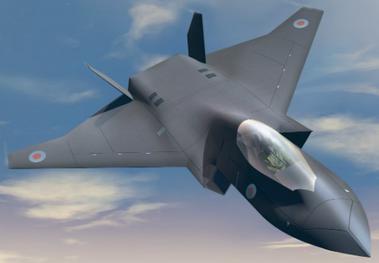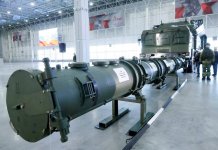The UK’s new and ambitious ‘Tempest program’ to develop a sixth-generation fighter jet that will replace its fleet of Eurofighter Typhoons is expected to complement the US-origin, stealth F-35 jets.
The Tempest program was launched in 2018 with the aim of developing the ‘optionally-manned’ stealth fighter jets which are expected to enter service in 2040.
Last year, at the Farnborough Air Show, a model of the Tempest was unveiled by British defence secretary Gavin Williamson.
According to a report in TheDrive, the twin-engine stealth fighter will supposedly boast a laundry list of sixth-generation technologies such as being optionally-manned, mounting hypersonic or directed energy weapons, and capability to deploy and control drone swarms.

Initially, the UK had planned to invest £2 billion ($2.6 billion) for “Team Tempest”. With BAE System leading the program along with the Royal Air Force, Rolls Royce will contribute engines while European firm MBDA will integrate weapons and Italian company Leonardo will develop sensors and avionics.
According to Justin Bronk, Research Fellow specialising in combat airpower and technology at Royal United Services Institute (RUSI), the Tempest concepts also feature a longer, wider fuselage than the F-35, which would improve the internal fuel load and allow more space for weapons bays and other internal sensor and/or combat payloads that might include the capacitors and coolant required for laser weaponry.
He further added that the twin engines with diverterless supersonic intakes would improve performance at high altitude as compared to F-35 that operates with a single-engine.
The ‘optionally manned’ fighter allows to use it as a drone as well. On one hand, the unmanned fighters allow stealth by eliminating the need for an onboard crew and the systems required for safety, however, Bronk argues that most of the design advantages gained by eliminating the need for an onboard crew are clearly lost in an optionally manned design.
With Abraham Accord, Have Israel, US & Arab Allies Opened A New Front Against Turkey & Iran?
“It still requires a cockpit, life support systems, physical controls and an instrumentation/information display system for the pilot, all of which add weight, complexity, reduces the space available for fuel, weapons and sensors, and the need for a canopy fairing limits how stealthy the airframe can be made,” he wrote.
Uncertainty now looms on UK’s plans to procure 138 F-35 jets.
Reportedly, the UK will now buy only half of the 138 F-35B Lightning II fighter jets that were earlier announced by Chancellor George Osborne in 2015. The jets are supposed to be shared between the Royal Air Force (RAF) and the Royal Navy.
Analysts believe that such a move could sour historical ties between the US and the UK. Bronk emphasises that an admission by the UK that it does not plan to buy all 138 jets would have a knock-on effect on unit costs for the whole F-35 programme at a sensitive time.
Passenger Airlines Could Fly As A Flock Under Airbus’ New Initiative
Equally, US President Donald Trump is keenly protective of US exports and would take any UK reduction in F-35 orders as a serious provocation at a sensitive time, he added.
He concluded saying that the UK government needs to pull off a balancing act to explain the long term financial viability of Tempest to industry and potential partners while maintaining its commitment to purchase 138 F-35s to the United States.




